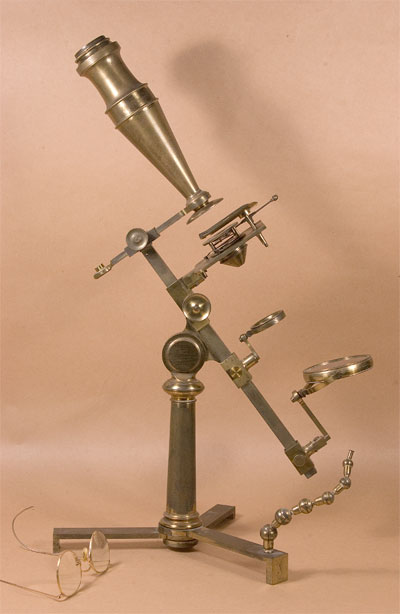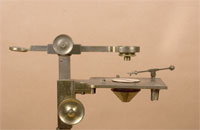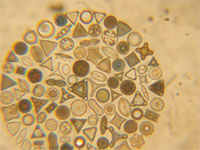 |
|||||
 |
 |
||||
 |
|||||
 |
 |
||||
Adams Universal Compound Microscope (No. 17 ) |
|||||||||||
 |
Age: c1790 Made by: George Adams Jr.. Made in: England |
||||||||||
 |
|||||||||||
|
ADAMS, LONDON
|
|||||||||||
 |
|||||||||||
|
Positioning the Adams microscope
|
|||||||||||
 |
|||||||||||
|
Imaging
|
|||||||||||
| This microscope by George Adams Jr. (1750-1795) is his "Universal Compound Microscope" which is described in his 1787 book Essays on the Microscope. It was made in approximately 1790 and is said* to be the last microscope model made and designed by Adams the Younger. This instrument is a large all brass microscope that stands approximately 50 cm tall. The square support limb is suspended by a heavy tapered column (24cm tall). This, in turn, is attached to a folding tripod base, the legs of which are 14cm long. The 1cm square limb supports the mirror, condenser lens, stage and body tube. It attaches to the top of the pillar by a large compass joint, which permits both rotating and tilting movement for inclination of the limb and microscope body. Focusing is by movement of the stage via a rack and pinion mechanism, the rack being cut into the front side of the support limb.
The stage, which is engraved "ADAMS, LONDON", has a centrally mounted Bonanni spring stage, and four holes for attachment of stage forceps, fish-plate, or other types of specimen manipulators. A sub-stage condenser lens can be moved up or down to focus the light or can be swiveled on its arm to the side, out of the optic axis. The large, movable, plano-concave mirror is double hinged near the base of the limb; an arrangement that is unusual for Adams' Universal microscopes. Attached near the end of one of the feet is a 12cm, ball-jointed arm which holds a single lens (missing), thus enabling its use as a simple microscope. The microscope body may be removed from the support arm and a single objective lens added in its place. In this configuration the microscope may be used as a low-magnification simple magnifier. The body tube (21cm long) is mounted on the top of the limb by a rectangular arm, adjustable by rack and pinion for axial positioning. At the rear end of this arm is hinged a threaded hole into which can be screwed individual lenses, thus making available another simple microscope, if desired. The tapered body tube, which screws into the end of the rectangular arm, has typical optics of the era: an objective lens, field lens, and two-lens eyepiece. The large mahogany storage box holds the accessories, including a total of seven additional objective lenses, two additional silvered Lieberkuhns, two live boxes, and several specimen slides. Imaging is quite good. Microscope No. 6 in the Golub Collection is an earlier version of the Adams Universal Microscope. George Adams died in 1795, and his firm was continued by his brother, Dudley Adams. Within a few years, however, W & S Jones bought the copyright to Adams' books and started making microscopes themselves. The Adams Universal Compound Microscope was the basis for the "W. and S. Jones Most Improved Microscope" of 1798. *(Clay and Court, 1932 p. 199) Featured 08/2020 |
|||||||||||